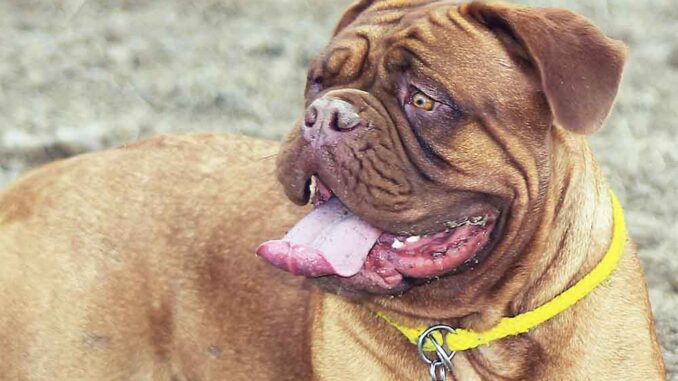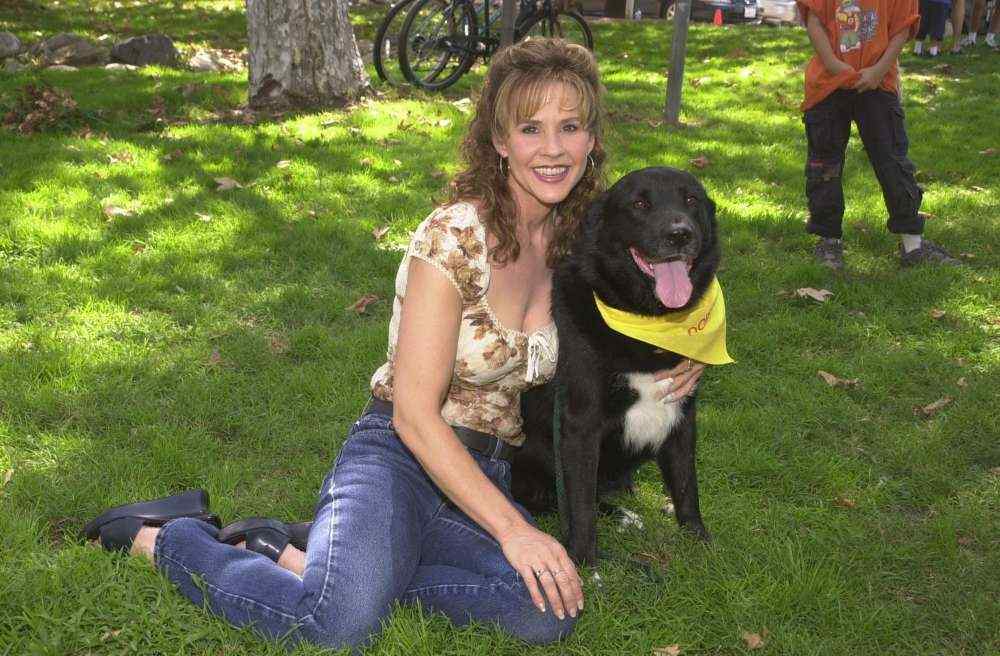
This article was updated on July 23rd, 2023

If you’ve found yourself here, you may have noticed that your dog’s breathing pattern has changed. Perhaps she’s drooling more than usual, or you’ve been noticing more of that doggy breath in your face than you’d like. If your dog appears to be struggling to catch her breath, collapses, or has unusually colored gums or tongue (especially if a blue or purple tinge), she must be seen at a veterinary clinic immediately. If you are in any doubt as to whether your dog’s breathing is a problem that needs to be addressed, then please call your veterinarian straight away.
In this article, we discuss what’s normal when it comes to your dog’s breathing, what’s abnormal, why it might be happening, and what can be done to help. If your dog is breathing heavily or fast at night while sleeping, also read our article that specifically looks at heavy breathing at night.
Panting: When it’s NOT heavy breathing
Fast breathing in dogs doesn’t always mean there’s a problem. Quick, shallow breaths with their mouths open and tongue hanging out could be panting. Dogs use panting to cool down when warm (they don’t sweat like us!) and can be seen on warm days or after exercising. All dogs will pant as part of their normal body function to regulate body temperature. However, panting can also be associated with pain, fear, and some medical conditions, so if you’re unsure, chat with your veterinarian.
How do you know if your dog’s breathing is too “heavy”?
What’s normal breathing:
Generally speaking, a dog will take between 28 and 34 breaths per minute. Keep track of your dog’s breathing pace by watching the tummy, just behind the rib cage, or by lightly placing a hand on the chest. Your dog’s breathing should be relaxed. Labored breathing signals a problem.
What’s “heavy” breathing:
The medical term for labored or heavy breathing is “dyspnea.” This is when there is an increased amount of effort involved in breathing. If your dog’s breathing rate is faster than normal, this is termed “tachypnea.”
Heavy breathing can be accompanied by sounds such as snoring or snorting (termed “stertor”) or a more high-pitched wheezing sound (termed “stridor”). These sounds indicate problems when the air travels from the nostrils to the lungs. Some short-nosed breeds will show signs of “stertor” when breathing due to their conformation – termed “Brachycephalic Obstructive Airway Syndrome” or BOAS.
Veterinarian Tip: If your dog is experiencing respiratory distress, seems to be struggling to breathe, or cannot get comfortable, take them to an emergency veterinarian immediately.
How to recognize when your dog’s breathing is abnormal:
It is not always straightforward to tell if your dog’s breathing is abnormal. Please speak to your veterinarian if there is any doubt, as breathing difficulties can rapidly become life-threatening. As we’ve said, panting is a normal body function for dogs. Abnormal heavy breathing usually includes the following:
- Breathing with more effort or faster than appropriate for the situation.
- Over (or well over) 34 breaths per minute.
- Your dog’s mouth may be closed or only slightly open.
- Heavy breathing is especially worrying if you notice your dog’s mouth is drawn very wide, so it looks like he’s grinning or his nostrils are moving. These are signs of severe breathing distress.
- Dogs with problems breathing will sometimes stretch out their neck and stick out their elbows. This is also a sign of severe problems.
- Any change to the color of your dog’s gums or tongue, especially a blue or purple tinge, can be a sign of life-threatening breathing complications.
- In some cases, heavy breathing in dogs may also show accompanying symptoms including, but not limited to: a swollen belly, vomiting or retching, a nosebleed or an inability to stand – all these symptoms likely mean that your dog should be seen by a vet right away (see the section titled “What if other signs accompany heavy breathing” for more information).
If there is any doubt, please speak to your veterinarian as soon as you can.

Why is my dog’s breathing heavy?
Heavy breathing can mean your dog is anxious, scared, or excited, but more commonly, it is associated with health problems and not just those affecting the lungs. Heavy breathing can be a sign of many different conditions. Some of the most common causes include:
- Lung disease
- Airway disease
- Trauma
- Heatstroke
- Heart disease
- Tumors
- Pain
- Fever
- Anemia
- Diseases causing belly enlargement
- Hormonal diseases
- Allergies
- Medications
- Poisons
Each of these conditions may also have symptoms other than a change to your dog’s breathing pattern. It is vital to give your veterinarian a comprehensive history of everything going on with your dog – even if the primary problem is his heavy breathing. There are many clues in a thorough medical history, and it will help your veterinarian’s detective work enormously! Treatment can vary tremendously depending on the condition diagnosed.
Is your dog also showing these other symptoms?
Below are other frequent symptoms that can accompany your dog’s abnormal breathing. Do not ignore these changes to your dog’s breathing pattern:
Labored breathing and a swollen belly
A swollen belly can occur with many different conditions in dogs, including heart disease, liver disease, hormonal diseases, gut disease, and cancers. Breathing changes may be directly related to the underlying condition or occur due to the swollen belly pressing on the lungs. If you notice your dog has a swollen belly and changes his breathing pattern, he should be seen by your veterinarian.
Heavy breathing and vomiting or retching
If you notice your dog is breathing heavily after vomiting, it can mean that she has accidentally breathed in vomit into the lungs – termed “aspiration pneumonia.” Aspiration pneumonia can be severe both because of the irritation to the lungs from the stomach acid and because bacterial infections can then develop. Your dog should be seen by your local veterinarian urgently.
If your dog is breathing heavily and you notice that they are retching or bringing up white foam, this can be a sign of a twisted stomach (“GDV”). This condition is rapidly fatal, and your pet should be seen by a veterinarian immediately.
Heavy breathing and nose bleeding
Dogs can develop nosebleeds for many reasons, including infections or tumors in the nose and problems with blood clotting. Heavy breathing may result from air struggling to pass through the nose due to these conditions or a concurrent lung problem. Unlike in humans, nose bleeds in dogs are usually always a sign of a significant medical issue, so it is essential to make a veterinary appointment.
Heavy breathing and being unable to stand
If your dog is breathing heavily and cannot stand, please seek emergency veterinary attention. These symptoms indicate the potential for many life-threatening diseases or injuries. Your pet needs urgent medical attention.
When do I visit the vet for my dog’s heavy breathing?
It won’t have gone unnoticed that this article is punctuated with the advice to get your dog seen by your veterinarian if you are worried about her breathing. While the cost of a trip to the clinic can be off-putting, it is essential to understand that when it comes to breathing problems, there is no guarantee that it will be OK to “wait and see.”
Dogs with significant breathing problems can quickly become tired (within a matter of hours), and when this happens, they can get into trouble and even die as a result. After a dog tires from labored breathing, there is very little the veterinarian can do to help.
Early intervention is critical. If you are unsure whether your dog needs to be seen, phone your veterinarian for telephone advice initially. They may suggest sending a video to allow for triage but are likely to advise a consultation to allow for a physical examination. If the cost of testing is high, your veterinarian will talk through all available options for your dog to ensure she is not suffering.
What will the veterinarian do?
As we’ve discussed, the first step is to make an urgent veterinary appointment if you notice a change in your dog’s breathing and she isn’t panting, too warm, or over-excited.
Here your veterinarian will take a detailed history, asking about all your dog’s body systems, not just the breathing problem. Your vet will complete a thorough examination, including a comprehensive sound assessment of the heart and lungs, with a stethoscope. Your vet will then suggest some treatment options or advise additional tests depending on their examination findings.
If your dog is in severe respiratory distress, they may need emergency hospital admission for oxygen and stabilization.
Disclaimer: This website's content is not a substitute for veterinary care. Always consult with your veterinarian for healthcare decisions. Read More.


My mix Bichon started to breath hard and has not pee or eaten I’m worried don’t know what to do for her